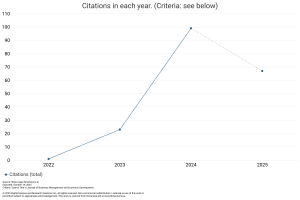Influence of Green Banking and Financial Performance Implementation to Profitability Levels in Conventional Banking Financial Companies Listed On the Indonesian Stock Exchange Period 2020
DOI:
https://doi.org/10.59653/jbmed.v2i01.499Keywords:
Green Banking, financial performance, return on assetsAbstract
The Interesting talks in the company in Indonesia is about social and environmental issues. This event corresponds to the publication of Presidential Regulation No. 92 of 2020 pertaining to the Ministry of Environment and Forestry. As a result, having complete and accurate environmental information will lead to better environmental performance. In this situation, financial services firms such as banks can help to realize a green environment by channeling financing to environmentally friendly and sustainable businesses. The purpose of this study was to analyze the effect of Green Banking and Financial Performance on the Level of Profitability in Conventional Bank Sector Financial Companies Listed on the Indonesia Stock Exchange (IDX) for the 2020-2022 term. For a total sample of 21 enterprises, this study used the purposive sampling method and secondary data in the form of financial statements. SPSS 24.0 was used to analyze the data using the multiple linear regression analysis approach. The findings revealed that Green Accounting has a marginally (Test t) insignificant influence on Return On Asset (ROA). Return On Asset (ROA) is influenced by Capital Adequacy Ratio (CAR), Non-Performing Loan (NPL), BOPO, and Loan to Deposit Asset Ratio (LDR).
Downloads
References
Anggraini, D., Aryani, D., & Prasetyo, I. B. (2020). Analysis of Green Banking Implementation and Financial Performance on Bank Profitability in Indonesia (2016-2019). JBMI (Journal of Business, Management, and Informatics), 17(2), 141-161. https://doi.org/10.26487/jbmi.v17i2.11264
Anjas, P. (2021). The Effect of Green Banking and Capital Adequacy Ratio on Financial Performance in Islamic Banks (Study on Indonesian Islamic Commercial Banks in 2016-2019). UNIVERSITAS ISLAM NEGERI RADEN INTAN LAMPUNG.
Bhardwaj, B. R., & Malhotra, A. (2013). Green Banking Strategies: Sustainability through Corporate Entrepreneurship. Journal of Business Management, 3, 180-193. https://api.semanticscholar.org/CorpusID:16701193
Indonesia Stock Exchange. (2022). Financial Report. https://www.idx.co.id/perusahaan-tercatat/laporan-keuangandan-tahunan. BEI. http://www.nber.org/papers/w16019
Friyanto. (2012). Auditing (1st ed.). Bayumedia Publishing Malang.
Hasibuan, M. S. P. (2017). Human Resource Management. Bumi Aksara. https://books.google.co.id/books?id=ZQk0tAEACAAJ
Ismail. (2018). Banking Management: From Theory to Application. Kencana. https://books.google.co.id/books?id=cs91DwAAQBAJ
Lako, A. (2019). Conceptual Framework of Green Accounting.
Lukman Dendawijaya. (2009). Banking Management. In R. Sikumbang (Ed.), Ghalia Indonesia (2nd ed., Issue 2).
Martono, A. H. and. (2010). Financial Management Theory and Application. In Ekonosia (2nd ed., Vol. 2, Issue 1). BPFE Gadjah Mada University.
Nurmalia, G. (2021). Green Banking and Capital Adequacy Ratio Affect Profit Growth of Islamic Commercial Banks in Indonesia. Scientific Journal of Finance and Banking, 4(2), 173-187.
Nurmiradiyanti, R. (2022). Analysis of the Effect of Green Accounting Implementation and Financial Performance on the Profitability Level of Commercial Banks registered with OJK in 2015-2021. In Sunan Gunung Jati, UIN: Vol. Faculty E (Issue Sunan Gunung Jati, UNI).
Pandia, F. (2012). Fund Management and Bank Health. In Rineke Cipta (1st ed.). Rineke Cipta. http://katalogarpusdaprovjateng.perpusnas.go.id/detail-opac?id=1054
Bank Response, I. (2014). Guarding-Green-Banking-Indonesia. Responsibank.Id, 1-36. www.responsibank.id
Sugiyono. (n.d.). Research and Development Methods Qualitative, Quantitative, and R&D Approaches. Qualitative Approach Research and Development Methods.
Sugiyono, D. (2013). Quantitative, Qualitative, and Action Research Methods.
Sujarweni, V. W. (2017). Financial Statement Analysis Application Theory and Research Results (1st ed.). New library press.
Widyastuti, P. F., & Aini, N. (2021). The Effect of CAR, NPL, LDR on Bank Profitability (ROA) in 2017-2019. Scientific Journal of Accounting Students) Ganesha University of Education, 12(03), 2614-1930.
Yogi Prasanjaya, A. A., & Ramantha, I. W. (2013). Analysis of the Effect of Car Ratio, Bopo, Ldr and Company Size on the Profitability of Banks Listed in Bei. Journal of Accounting, Udayana University, 41, 2302-8556.
Zhelyazkova, V., & Kitanov, Y. (2015). Green Banking - Definition, Scope and Proposed Business Model. Journal of International Scientific Publications, 9(1), 309-315.
Downloads
Published
How to Cite
Issue
Section
License
Copyright (c) 2023 Friyanto Friyanto, Yosar Haritsar; Nadia Fransiska Amboisa

This work is licensed under a Creative Commons Attribution-ShareAlike 4.0 International License.
Authors who publish with this journal agree to the following terms:
- Authors retain copyright and grant the journal right of first publication with the work simultaneously licensed under a Creative Commons Attribution-ShareAlike that allows others to share the work with an acknowledgement of the work's authorship and initial publication in this journal.
- Authors are able to enter into separate, additional contractual arrangements for the non-exclusive distribution of the journal's published version of the work (e.g., post it to an institutional repository or publish it in a book), with an acknowledgement of its initial publication in this journal.
- Authors are permitted and encouraged to post their work online (e.g., in institutional repositories or on their website) prior to and during the submission process, as it can lead to productive exchanges, as well as earlier and greater citation of published work (See The Effect of Open Access).





























